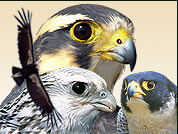Perhaps it should be viewed as a healthy sign of the diversity and vigor of the global interest in animal conservation that so many terms have emerged in recent years to describe the population status of species. The categories used in GRIN are based with slight modifications on the IUCN Red List Categories (IUCN. 1996. IUCN Red List of threatened animals), as follows (see the IUCN list for more complete definitions of these terms):
Extinct:It is known for certain that the last individual died. Extinct in wild: Species surviving only in captivity. Critically Endangered: Species facing imminent extinction. Species in this category may be represented by less than 100 living individuals. Endangered: Species facing a high risk of extinction in the near future without human intervention. Vulnerable: Species facing a high risk of extinction the mid-term future, given present trends in population declines and threats. This term is generally equivalent to "threatened," a category used in many other classifications. Near threatened: Species not in trouble at the moment, but which require some level of management to maintain healthy populations. Equivalent to "Conservation Dependent" in other classifications. Lower risk: Species which are not at risk at the species level, although they may include subpopulations that are experiencing problems. Equivalent to the "Least Concern" category of BirdLife International. Data deficient: Species for which too few data are available to adequately assess their status. Following further study, many of these may prove to be Conservation dependent or Vulnerable. Categorizing the conservation status of the rarest and the most common species is relatively straightforward, but dealing with the ones that fall in between these extremes can be highly subjective. Furthermore, the status of some widespread species, e.g., Harpy Eagle, varies dramatically in different portions of the range, making a single designation fairly meaningless. Where such choices exist, the category in the Species Database reflects the apparent status of the species as a whole, but more detailed, country-specific information can be found in the species accounts.
For the rarest categories (Critically Endangered, Endangered, and Vulnerable), the designations of Stattersfield and Capper (2001) in their monumental "Threatened birds of the world," and those of the BirdLife International website are mostly followed, except where more recent information or the collective judgments of experts within the range of the species indicate that a different status is more appropriate. Justification for departures from the IUCN/BirdLife categories is provided in the Conservation sections of the species accounts.
One of the most important objectives of GRIN is to identify raptor species for which we lack basic natural history and population status information, and these fall into the "Data Deficient" category. Some of these species may prove to be relatively common once they are adequately studied, but others are likely to be rare enough to require conservation action. This category has been used more liberally in GRIN than by BirdLife for diurnal raptors. It is hoped that this list will be useful in prioritizing research directions and conservation efforts.
There are many opportunities for refinement in the Conservation Status section, and the category assignments presently represent the best estimates, based on the literature and personal communications. It is hoped that GRIN users will offer suggestions for further refinements of this feature. |

